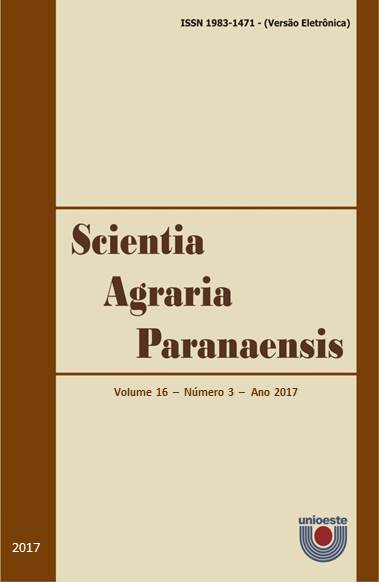Stored seeds crambe (Crambe abyssinica Hochst) as affected by priming
Keywords:
embebição, hidratação controlada, armazenamento.Abstract
The crambe (Crambe abyssinica Hochst) has been grown mainly due to their potential for oil production in their seed and as fodder plant. For this species, the high oil content impairs the storage potential of the seeds as well as the use of seeds in the presence of pericarp of the fruit at the time of sowing and the low availability of water in the soil may provide uneven germination. To facilitate the performance of the seeds can be used the seed priming techniques. The objective of this research was to evaluate the efficiency of different priming techniques in physiological quality of crambe seeds stored under controlled conditions. Therefore, the experiment was conducted in the period 2015-2016 using classified seeds, processed and packed in paper bags. After zero, three and six months of storage, the seeds were submitted to unmonitored hydration techniques (immersion in water), matriosmopriming with PEG 6000 -0.2 MPa, moist atmosphere, matripriming and unconditioned seeds were used as control. Later, the seeds were dried and evaluated by germination and vigor tests (first count, seedling performance, seedling emergence and electrical conductivity). From the results, it can be concluded that there was favoring the germination of seeds and dry mass of lot 1 seedlings after they have been submitted to matriosmopriming, to zero, three and six months. The matripriming favored the germination rate of lot 3 seed, three and six months of storage.
Downloads
Published
How to Cite
Issue
Section
License
Aviso de Direito Autoral Creative Commons
Política para Periódicos de Acesso Livre
Autores que publicam nesta revista concordam com os seguintes termos:
1. Autores mantém os direitos autorais e concedem à revista o direito de primeira publicação, com o trabalho simultaneamente licenciado sob a Licença Creative Commons Attribution que permite o compartilhamento do trabalho com reconhecimento da autoria e publicação inicial nesta revista.2. Autores têm autorização para assumir contratos adicionais separadamente, para distribuição não-exclusiva da versão do trabalho publicada nesta revista (ex.: publicar em repositório institucional ou como capítulo de livro), com reconhecimento de autoria e publicação inicial nesta revista.
3. Autores têm permissão e são estimulados a publicar e distribuir seu trabalho online (ex.: em repositórios institucionais ou na sua página pessoal) a qualquer ponto antes ou durante o processo editorial, já que isso pode gerar alterações produtivas, bem como aumentar o impacto e a citação do trabalho publicado (Veja O Efeito do Acesso Livre).
Licença Creative Commons
Esta obra está licenciada com uma Licença Creative Commons Atribuição-NãoComercial-CompartilhaIgual 4.0 Internacional, o que permite compartilhar, copiar, distribuir, exibir, reproduzir, a totalidade ou partes desde que não tenha objetivo comercial e sejam citados os autores e a fonte.


